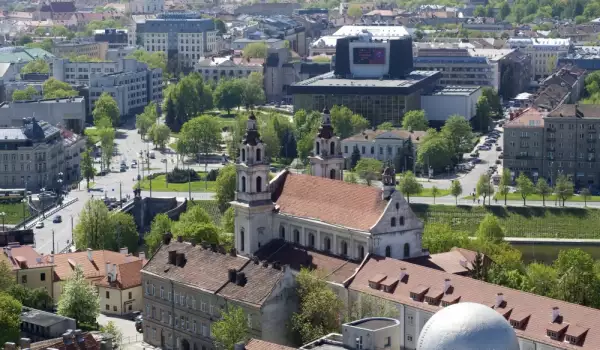Vilnius

Vilnius is a Lithuanian city of over 560, 000 people. The city is the capital of the country. The name of the town's name comes from the River Vilnia.
It is believed that Vilnius as a city, begins to exist by the middle of the thirteenth century. Then the first Catholic Franciscan church was built here. Officially the city was first mentioned in written sources in the early fourteenth century. Then Vilnius functioned as the capital of the Grand Duchy of Lithuania.
According to legend, the ruler of Lithuania, Gediminas dreamed of an iron wolf that howled upon a high hill. As happened at that time, he had a priest who interpreted his dreams and the ruler acted according to his precepts. Gediminas asked for his interpretation of the dream and the priest found that the iron wolf is a symbol of the fortress to be built on the hill, to be used to extend the glory of Lithuania worldwide.
The town is strategically located as is surrounded by forests and wetlands that are difficult to penetrate. This was important as the Grand Duchy of Lithuania was often victim to attacks by many people willing to conquer the territory and its riches.

Gediminas expanded the Grand Duchy, using different methods - he achieved his goal by war, strategic alliances and marriages.
During his rule, the Duchy of Lithuania covered the territory of modern Ukraine, part of Poland, the territory of Lithuania and Belarus, and parts of Russia.
After the death of Gediminas civil war broke out. After the civil war, followed the contracts that led to the Union in 1569 when the Polish-Lithuanian Commonwealth was founded. Rulers of this federation wore the title of Grand Duke of Lithuania and King of Poland.

In the early sixteenth century, the city walls were completed, which encircled the city and through them passed through nine gates. In 1544, Sigismund August moved the court in the city.
In 1579 Vilnensis Societatis Iesu the university was founded, which became one of the most important scientific and cultural centers of the region and was the most notable scientific center of the Commonwealth.
During its rapid development, the city was open to immigrants from the territory of the Grand Duchy. At that time, in the city were spoken Latin, Hebrew, Polish, Russian, German and Old Slavic, because of this, the city has been compared to Babylon. In the seventeenth century, the heyday period of Vilnius ends.
A series of wars, known as the Flood folowed. During the Russo-Polish war, Vilnius was occupied by Russian forces, was robbed and burned, and its population was massacred. During the Great Northern War the city was pillaged by the Swedish army. In 1710 the city kindled an epidemic of bubonic plague and thirty-five thousand people died. In the early nineteenth century, the population of the town consisted of twenty thousand people.

During World War 1, Vilnius became known as the "pearl of the Polish crown". The Act of Independence of Lithuania was published in 1918. After German control, control of Soviet troops followed. In October 1920, an uprising broke out, placing the city and its surroundings in a country named the Republic of Central Lithuania. Two years later the entire area joined Poland.
A new period of economic development followed and in 1931 the city had 195, 000 people. In 1939, Vilnius was seized by the Soviet Union. Originally the town was part of the Belorussian Republic, which led to the opening of schools in the Belarusian city. But then, it once again returned to Lithuania.
In 1940 the whole of Lithuania was annexed by the Soviet Union. Over forty thousand people were arrested and sent into political camps. In June 1941, Vilnius was captured by the Germans. During the Holocaust, over ninety percent of Lithuania's population was killed.
In 1944, Vilnius was again conquered by the Soviet Army and became a republic of the Soviet Union. In 1990, Lithuania seceded from the Soviet Union and declared itself the independent Republic of Lithuania. Military operations in which several people were killed and several people were wounded followed.
Independence of Lithuania was recognized in 1991. This led to the rapid growth of Vilnius. Today, tourists can enjoy the historic center of old city, as well as the tower of Gediminas, the Cathedral Square and also the royal palace in the city.
Buildings in Vilnius are an example of brilliant Gothic, Baroque and Renaissance architecture. Vilnius Cathedral and its bell tower are one of the biggest attractions and is not only the city in the whole of Lithuania. It was built in 1387.
Museum of Genocide is located in a building that was once a KGB prison. Tourists do not go by without noticing the cells for prisoners and rooms specially designed for different kinds of torture, to extract valuable information.
The gate of twilight is one of the major attractions of the city. It is the sole survivor of the nine gates of Vilnius. The gate of twilight is known for the icon of the Virgin Mary, which is made of silver and gold.
An often photographed landmark is the hill of three crosses on which stand three huge white stone crosses.








